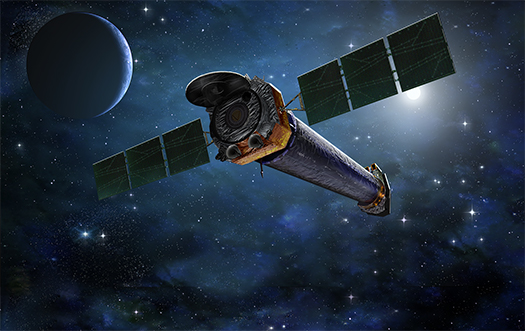For Release: February 23, 2022
NASA/CXC

NASA's Chandra X-ray Observatory has returned to science operations, as teams work to resolve a power supply problem with the High Resolution Camera (HRC). NASA suspended all observations Feb. 9 while scientists and engineers analyzed the situation.
On Feb. 20, Chandra resumed a full schedule of science observations using the Advanced CCD Imaging Spectrometer (ACIS) instrument, which is typically used for the majority of Chandra observations. The HRC remains in safe mode.
Because of the current situation, the team has switched to using the ACIS detector to monitor the spacecraft's radiation environment — a function normally provided by the HRC, as well as ACIS. In addition, as an extra precaution during high-radiation periods, the team will put the High Energy Transmission Grating, another instrument aboard Chandra, into the path of the X-rays prior to spacecraft entry into Earth's radiation zones. During its highly elliptical orbit around Earth, the Chandra spacecraft spends about 15% of its time passing through radiation belts — zones of energetic, charged particles that surround the planet.
The Chandra science instrument and engineering teams continue to analyze the cause of the HRC power supply issue, as well as potential approaches to enable the HRC again. The spacecraft is otherwise healthy and operating normally.
Chandra has operated for over 22 years, well into its extended mission.
Previous update (posted February 14, 2022)
On Wednesday, Feb. 9, 2022, routine monitoring data from NASA's Chandra X-ray Observatory indicated a power supply problem in the spacecraft's High Resolution Camera. Chandra mission specialists have paused science operations and put the four science instruments into safe mode while they analyze the situation and determine the appropriate response. The spacecraft itself is operating normally. Launched in 1999, Chandra has delivered a wealth of images and data that help scientists understand the structure, evolution, and exotic objects of our universe. NASA will provide more information as it becomes available at nasa.gov/Chandra.
Media Contacts:
Megan Watzke
Chandra X-ray Center, Cambridge, Massachusetts
617-496-7998
mwatzke@cfa.harvard.edu
Molly Porter
Marshall Space Flight Center, Huntsville, Alabama
256-544-0034
molly.a.porter@nasa.gov


